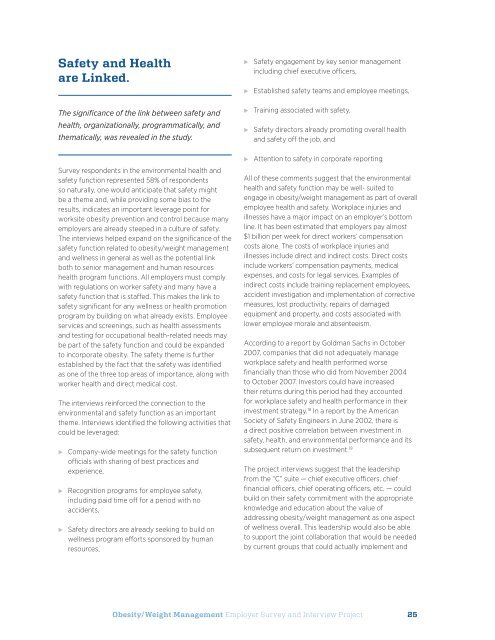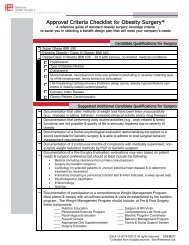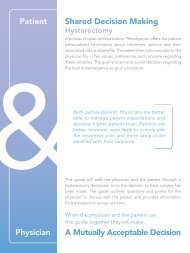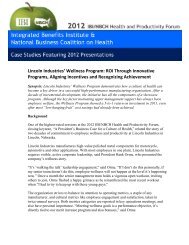Obesity/Weight Management Employer Survey and Interview Project
Obesity/Weight Management Employer Survey and Interview Project
Obesity/Weight Management Employer Survey and Interview Project
- No tags were found...
Create successful ePaper yourself
Turn your PDF publications into a flip-book with our unique Google optimized e-Paper software.
Safety <strong>and</strong> Healthare Linked.The significance of the link between safety <strong>and</strong>health, organizationally, programmatically, <strong>and</strong>thematically, was revealed in the study.<strong>Survey</strong> respondents in the environmental health <strong>and</strong>safety function represented 58% of respondentsso naturally, one would anticipate that safety mightbe a theme <strong>and</strong>, while providing some bias to theresults, indicates an important leverage point forworksite obesity prevention <strong>and</strong> control because manyemployers are already steeped in a culture of safety.The interviews helped exp<strong>and</strong> on the significance of thesafety function related to obesity/weight management<strong>and</strong> wellness in general as well as the potential linkboth to senior management <strong>and</strong> human resourceshealth program functions. All employers must complywith regulations on worker safety <strong>and</strong> many have asafety function that is staffed. This makes the link tosafety significant for any wellness or health promotionprogram by building on what already exists. Employeeservices <strong>and</strong> screenings, such as health assessments<strong>and</strong> testing for occupational health-related needs maybe part of the safety function <strong>and</strong> could be exp<strong>and</strong>edto incorporate obesity. The safety theme is furtherestablished by the fact that the safety was identifiedas one of the three top areas of importance, along withworker health <strong>and</strong> direct medical cost.The interviews reinforced the connection to theenvironmental <strong>and</strong> safety function as an importanttheme. <strong>Interview</strong>s identified the following activities thatcould be leveraged:E Company-wide meetings for the safety functionofficials with sharing of best practices <strong>and</strong>experience,E Recognition programs for employee safety,including paid time off for a period with noaccidents,E Safety directors are already seeking to build onwellness program efforts sponsored by humanresources,E Safety engagement by key senior managementincluding chief executive officers,E Established safety teams <strong>and</strong> employee meetings,E Training associated with safety,E Safety directors already promoting overall health<strong>and</strong> safety off the job, <strong>and</strong>E Attention to safety in corporate reportingAll of these comments suggest that the environmentalhealth <strong>and</strong> safety function may be well- suited toengage in obesity/weight management as part of overallemployee health <strong>and</strong> safety. Workplace injuries <strong>and</strong>illnesses have a major impact on an employer’s bottomline. It has been estimated that employers pay almost$1 billion per week for direct workers’ compensationcosts alone. The costs of workplace injuries <strong>and</strong>illnesses include direct <strong>and</strong> indirect costs. Direct costsinclude workers’ compensation payments, medicalexpenses, <strong>and</strong> costs for legal services. Examples ofindirect costs include training replacement employees,accident investigation <strong>and</strong> implementation of correctivemeasures, lost productivity, repairs of damagedequipment <strong>and</strong> property, <strong>and</strong> costs associated withlower employee morale <strong>and</strong> absenteeism.According to a report by Goldman Sachs in October2007, companies that did not adequately manageworkplace safety <strong>and</strong> health performed worsefinancially than those who did from November 2004to October 2007. Investors could have increasedtheir returns during this period had they accountedfor workplace safety <strong>and</strong> health performance in theirinvestment strategy. 18 In a report by the AmericanSociety of Safety Engineers in June 2002, there isa direct positive correlation between investment insafety, health, <strong>and</strong> environmental performance <strong>and</strong> itssubsequent return on investment. 19The project interviews suggest that the leadershipfrom the “C” suite — chief executive officers, chieffinancial officers, chief operating officers, etc. — couldbuild on their safety commitment with the appropriateknowledge <strong>and</strong> education about the value ofaddressing obesity/weight management as one aspectof wellness overall. This leadership would also be ableto support the joint collaboration that would be neededby current groups that could actually implement <strong>and</strong><strong>Obesity</strong>/<strong>Weight</strong> <strong>Management</strong> <strong>Employer</strong> <strong>Survey</strong> <strong>and</strong> <strong>Interview</strong> <strong>Project</strong> 25









